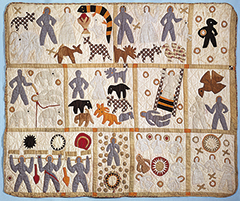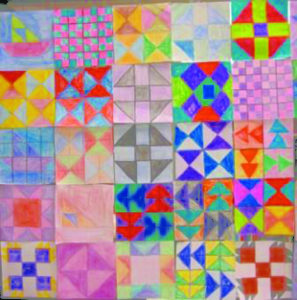 By Anne Gilbert
By Anne Gilbert
Since the 1980s interest has continued to grow in African-American quilting history. The recent opening of the Civil Rights Museum is sure to bring more examples to light.
Eli Leon, an Afro-American, began an important collection when he acquired a Guggenheim Award to aid in his research of historical Afro-American quilts. This resulted in his writing many books on the subject.
Author/African quilt historian Cuesta Benberry has said,”in the case of slave produced quilts their talents depended on the skills of their mistress, who instructed them.” Now we know that not only have many Afro-American quilts been identified along with their distinctive patterns, but how they were possibly used as signals to slaves escaping via the underground railway. The colorful block patterns were a code.
 Two early identified Afro-American quilts authenticated are pictorial appliquéd Bible quilts made by Harriet Powers in 1886 and 1898. It is known she was born a slave in 1837. This type of quilt is known as a “story” quilt. They are in the Smithsonian Museum.
Two early identified Afro-American quilts authenticated are pictorial appliquéd Bible quilts made by Harriet Powers in 1886 and 1898. It is known she was born a slave in 1837. This type of quilt is known as a “story” quilt. They are in the Smithsonian Museum. Over the years the “pine pattern” and the “tree of Paradise” pattern have been made from the early 20th century and still popular with quilters.
CLUES: According to historians there are seven clues to identifying Afro-American quilts. They include vertical stripes that relate to a West African tradition of strip quilts: bold, bright colors, overly large designs, multiple-patterning, asymmetry, symbolic forms. These days quilters do a lot of improvisation.
Another clue is the use of bright, contrasting colors used close together. Some typical color combinations might be purple and yellow or orange with green.
While traditional quilts use 10-12- or 16 inch uniform size blocks, Afro-American quilts use large scale designs. They also made quilts in the traditional Anglo American style, but added their own distinctive touches.
To learn more about old and contemporary examples check out museum exhibits and the many books on the subjects. Who knows where an early historic example will turn up.
PHOTO: (1) Afro-American “Biblical” subject quilt. Made By Harriet Powers. C. 1885-1886 PHOTO CREDIT: National Museum of American History PHOTO (2): Underground Railway code quilt. PHOTO CREDIT: atlantablackstar.com.















Follow Us